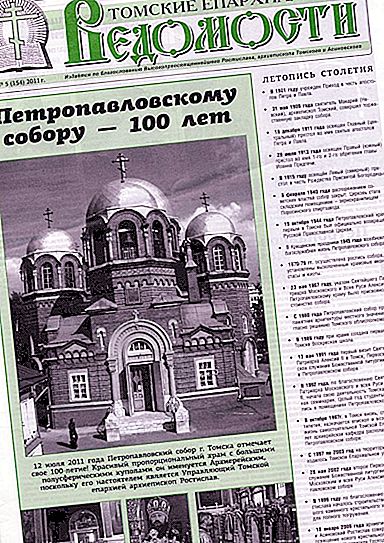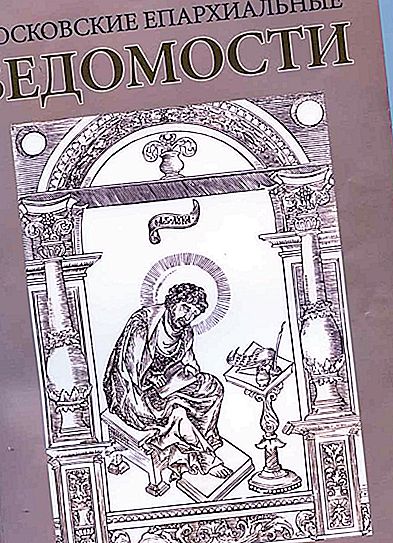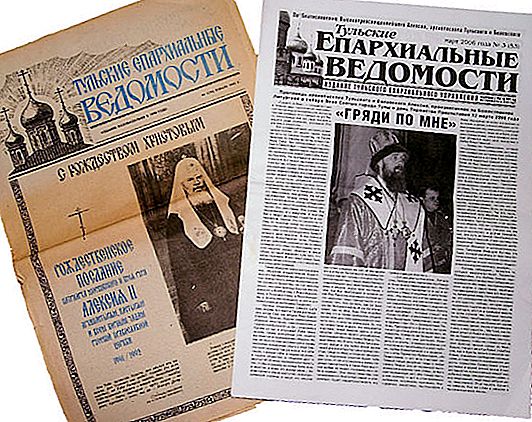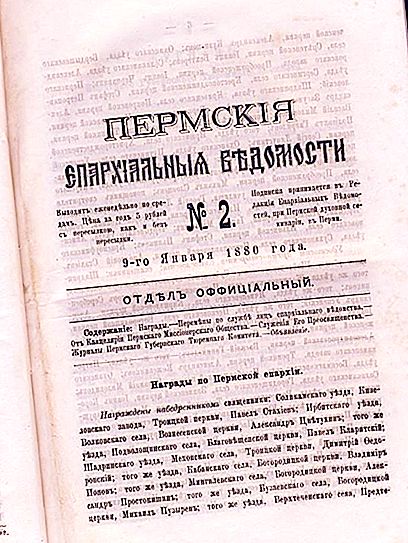Diocesan Gazette is a church newspaper publication that was published from 1860 to 1922. 63 dioceses of the Russian Orthodox Church took part in this project. This project was developed in 1853 by the Kherson Archbishop. And presented to the Holy Synod only six years later. The synod liked the idea, and the approval of the program was signed in November 1859. And at the end of December of that year, a decree was sent to the dioceses on the beginning of the publication of the Diocesan Vedomosti. The history of church newspapers is very interesting and informative, it is worth exploring in more detail.
The essence of the church project

When applying for the start of a new church project, the Kherson Archbishop stated the following considerations:
- The publication of Vedomosti significantly reduced the need for the correspondence of numerous papers and documents.
- The Vedomosti could reduce the number of false teachings; they brought the diocesan administration closer to the flock.
- Vedomosti will save the local clergy from various trips, and the main news will be available from the publication.
It is known that after the start of the publication of the newspaper, the number of church correspondence decreased by half. The publication made it easier to inform local clergy. "Vedomosti" covered information on the state of theological schools, deaneries congresses, the election of clergy, and general Christian issues were also discussed.
Local "Vedomosti"

Since 1860, thanks to the request of the Yaroslavl bishop, local "Diocesan Vedomosti" began to be published. "Yaroslavl Vedomosti" ahead of Kherson for a couple of months. After that, other local editions of church news began to be published: Polish, Lithuanian, Arkhangelsk, Yenisei, Caucasian, Stavropol, Kamchatka and others. Some editions or part of them had a non-standard name. For example, The Spiritual Bulletin of the Georgian Exarchate, Archangel Diocesan News, News of the Kazan Diocese, Riga Diocesan Sheet, News of the St. Petersburg Diocese, Kholm-Warsaw Diocesan Bulletin, etc.
Vedomosti was published twice a month, and some of them - every week. Magazines consisted of two parts: official and unofficial. The official covered decrees of the diocesan authorities and state institutions, regulatory acts of the emperor, various reports and other information of church organizations and diocesan institutions.
In the second part, publications of the Holy Fathers, sermons, teachings, spiritual advice, conversations, church-historical works, historical information about the dioceses and much more were printed. Some editions of the Diocesan Gazette were issued in the form of books, brochures and leaflets.
Voronezh publications
"Voronezh diocesan sheets" were issued from January 1, 1866 to 1909. At first, newspapers appeared twice a month, and starting in 1910 - weekly.
An edition was issued of the Zadonskaya and Voronezh dioceses. In addition to the magazine itself, its annexes were also printed. The magazine covered important decrees, official acts. The appendix published articles of an edifying nature. Since 1868, the magazine has been divided into official and unofficial parts with the preservation of individual applications. And in 1877, the publication took the old form, in which the unofficial part was located in the appendix. Later, such applications became known as the "unofficial part".
In the first years of the publication’s life, it printed translations of the writings of Clement of Alexandria, the Apostle Hermas, Origen, Blessed Augustine, etc. From 1872 to 1883, the publication printed the “Months” of saints, and a lot of information about local saints was also covered. For example, about Tikhon Zadonsky and Mitrofan, about the Voronezh bishop. Numerous articles on church holidays were published, certain Gospel events were described, events that took place in ancient churches, historical facts about local churches. Some of the articles were not published immediately, but after a long time they were still published.
The Voronezh Diocesan Vedomosti did not pay much attention to the history of local churches, as several other newspapers were published in Voronezh that paid full attention to the history of their region. More attention was paid to the publication of the history of All Russia and the Russian Church. A series of stories about the enlightenment of Russia and the Russian people was printed, attention was paid to the Great Moscow Cathedral in 1666-1667. A description of the local monasteries, churches and theological schools was still published. Often in the newsletter biographies of various local spiritual leaders were printed.
The appendix included the work of clergymen, teachings, discussions, an unofficial description of the sacred meetings, and much more. The publication lasted until 1918.
In 1990, the Voronezh Diocesan Bulletin began to be published again, from 1977 the Voronezh Orthodox newspaper, and from 2001 the Obraz newspaper.
Oryol publications
"Oryol diocesan sheets" began to be published thanks to the initiative of the bishop of Sevsky and Oryol. The first issue of the magazine was published in 1865. The editor of Oryol Vedomosti was Peter Polidorov. He served as the cathedral archpriest in Orel, was close to the bishop and wrote a separate essay about him.
The purpose of the publication of the "Oryol diocesan sheets" was to improve the life of the clergy, their desire for spiritual exaltation. The magazine was published not only for clergy, but also for secular people. Publishers tried to make it versatile and interesting for everyone.
Initially, the journal included the following sections:
- Orders and decrees.
- Diocesan Chronicles.
- Teachings, spiritual discussions, etc.
A year later, the structure of the publication was changed. It began to consist of official and unofficial parts.
The official published decrees and decrees of the Holy Synod, various orders of the diocesan leadership, the highest manifestos, reports, information on dismissal and appointment, awards, vacancies for clergy and clergy, as well as on the adoption of Christianity by people of a different faith who lived on the territory of the Oryol diocese.
The unofficial part of the publication published articles of a spiritual and instructive nature, statistics on visits to churches and temples, on theological seminaries and schools, and on charitable institutions. As well as biographies of clergy, historical information about holy places, announcements, news from other dioceses.
The publication came out a couple of times a month. Its size ranged from one and a half to three printed sheets. Close attention was paid to issues of spiritual life, a healthy lifestyle, historical and local history materials.
Over the years of its existence, the magazine’s typography has changed several times. Currently, the "Oryol diocesan sheets" are a valuable information source. Experts have repeatedly thought about publishing an entire anthology of Vedomosti.
Orenburg publications
The Orenburg Diocesan Gazette was published from 1873 to 1917. The magazine bore the non-standard name "Orenburg Church Public Messenger". It printed the details of the church life of the diocese. Initially, the magazine was published twice a month, later the frequency of output increased to 52 per year.
“Orenburg diocesan sheets”, like many others, consisted of two sections: official and unofficial. Archpriest Vasily Olshansky was originally the editor of the official part, and the secretary of the Orenburg Consistory Efrimovsky-Mirovitsky became the editor of the unofficial part of the magazine.
The official part of the publication contained orders and decrees of the Holy Synod, the diocesan and higher authorities, protocols of diocesan congresses, information on the appointment and dismissal, etc.
The unofficial section published articles on the historical information of the region, discussed spiritual discussions, church holidays, theological issues, statistics on parishioners visiting churches, etc.
Moscow editions

The Moscow Diocesan Gazette is the official church monthly publication. The newspaper began its existence in the late 19th century and is currently being published. For the history of the Russian people, the publication is valuable and important. In it you can learn about the clergy, famous clergy. It reflects information about appointments, dismissals, transfers to another duty station, church awards, and dates of death.
The Moscow Diocesan Gazette initially included two sections: official and unofficial.
The official printed decisions and decrees of the Holy Synod, information on the appointment and transfer to another place of service for clergy, government decrees and much more.
The unofficial part contained teachings and instructions, stories and narratives about the holy places of the diocese, unofficial descriptions of church meetings, etc.
Smolensk editions
The Smolensk Diocesan Vedomosti is the publication of the newspapers of the Smolensk diocese, which was published from 1865 to 1918. The journal began to be published thanks to the initiative of the editor of the Smolensk Theological Seminary Pavel Lebedev. The first issue of the Smolensk Diocesan Gazette was published in 1865.
Like other similar publications, the magazine consisted of the official part and the “addition”. Later it became known as the unofficial part.
The supplement contained a variety of sermons, conversations, instructions, information about the clergy of the diocese and statistics of parishes in churches, churches, and monasteries.
The official part, as usual, contained official decrees, documents and materials.
The editors of the Smolensk Diocesan Vedomosti were at different times Archpriest Daniil Petrovich Lebedev, Archpriest Pavel Efimovich Obraztsov, Pavel (Lebedev), Ivan Alexandrovich Moroshkin, Sergei Alekseevich Solntsev, Nikolai Alexandrovich Vinogradsky, Nikolai Nikolaevich Sokolov, Nikolai Nikitich Redkov, Petr Alekseevich Cholkov, Nikolai Nikitich Redkov, Petr Alekseevich Cholkov, Peter Nikolaevich Sametsky.
The newspaper was published twice a month. Initially, its circulation was 800 copies, 600 of which were distributed between dioceses. "Smolensk diocesan sheets" in 1918 ceased to exist. The publication resumed its activities only in 1991. The name of the magazine has not changed.
Ekaterinburg editions
The Yekaterinburg Diocesan Gazette was published from 1886 to 1917 in the Yekaterinburg Diocese.
The publication, as usual, contained the official and unofficial parts. The official printed official documents, legal acts, reports, information on appointments and dismissals, as well as transfers to another place. Important state issues and decisions of the Holy Synod were also published here.
The unofficial part of the Ekaterinburg Diocesan Vedomosti contained information on parish schools, monasteries, theological seminaries, as well as the teachings and edifications of clergymen. In the unofficial part of the publication, much attention was paid to the needs of education, spiritual education, and problems of the Old Believers.
Ryazan
"Ryazan Diocesan Vedomosti" is a church publication of the Ryazan diocese. The first magazine was released in 1865. Priest Nikolai Glebov initiated the publication of the magazine. The Holy Synod signed a decree on the mandatory subscription of all dioceses to the "Ryazan Gazette". Like other similar newspapers, the magazine had official and unofficial sections.
The official one contained the orders of the emperor in the Ryazan province, decisions of the Holy Synod, orders for ordination, diocesan orders, lists of distribution to church and priestly places, information about dismissal. Also in the official section published information about the retirement due to death.
An unofficial section of the bulletin published information about significant events taking place in the Ryazan region, articles of a theological nature, information about schools, various societies, schools and guardianships.
The clergy attempted to organize feedback with subscribers of the publication. But this attempt was unsuccessful.
Starting in April 1917, the Diocesan Vedomosti changed its name to Voice of the Free Church, and a year later the publication completely ceased to exist.
Kursk editions
"Kursk diocesan sheets" began to be issued in 1871. As you can see, the Kursk diocese began to publish church news much later than other dioceses. The magazine was published twice a month. Beginning in 1872, the publication began to be printed weekly.
The journal of the Kursk diocese was founded in the image of other church magazines. Two departments were placed in it: official and unofficial. In the official one could find official orders, decrees and documents. The unofficial published information that was of interest to the general population.
Where else was the church newspaper published
In addition to the above areas, church publications came out in other areas of the country. For example, there were the "Penza diocesan sheets." They began to be published in the city of Penza in 1866, and ended their existence only in the early 2000s. "Tobolsk diocesan sheets" were published on the territory of the Tobolsk diocese. The publication period is from 1882 to 1919. "Tula diocesan sheets" were published from 1862 to 1928.

In the Tomsk diocese, a church magazine was published from 1880 to 1917. The publication was called "Tomsk diocesan sheets." In Vologda, a church publication was published from 1864 to 1917. The magazine was called "Vologda diocesan sheets."
Collections

All news editions are collected in archives. At the moment, anyone can find the release they need and read. The Index of Diocesan Sheets will help you find the right issue of the journal. On the Internet there are many sites on which you can read or download material of interest for free.
The most complete collection of "Diocesan Gazette" is stored in the Russian National Library. For the years 1860-1917, the volume of this collection amounted to more than 3 million sheets.
According to statistics, the most widely read journals of the Diocesan Vedomosti are the publications of the Oryol diocese for 1886-1987, the Orenburg - for 1899, the Voronezh - for 1882, the Grodno - for 1902, and the Astrakhan - for 1876.
Church newspapers and magazines today

The periodical press of the Russian Orthodox Church has long taken its place in the system of journalism and the media. Printing of church publications, divided by territory, dates back to the 19th century, when the Kherson archbishop proposed his famous project to the Holy Synod. It was then that newspapers and magazines devoted to church life gradually spread throughout the expanses of Russia.
Thanks to the resumption of church publications in recent times, churches and, of course, Orthodox journalism have been revived.
Currently, the Moscow Patriarchate includes 164 dioceses. Each of them has its own printing houses. Each diocese publishes more than one Orthodox publication. In fact, at the moment there are a lot of church magazines and newspapers in the Russian Federation. The Orthodox Church, publishing its literature, not only facilitates communication between dioceses, but also calls for an increasing number of believers to visit their parishes.
The names of today's newspapers are diverse. The main feature of church publications remains the division of the readership according to territorial criteria. The diocesan press is currently distinguished by its latency, that is, secrecy from a wide audience. This factor significantly complicates its detailed study. Another hallmark of religious publications is the non-periodicity of publications. This is due to the fact that unprofessional journalists often work with this literature. Many readers of church magazines and newspapers of our time are faced with the problem of the disappearance of the publication. The man is confused, not understanding where his favorite press went.
How is the choice of type of publication determined? Currently, dioceses opt for publishing newspapers. This is due to the lower cost of the product. The fact is that not every diocese can afford the release of a colorful magazine. This is an expensive pleasure.
But larger dioceses publish religious literature in journal form. This makes it possible to cover more church issues. Magazines are issued in the following dioceses: St. Petersburg, Tver, Voronezh, etc. These publications are oriented mainly to clergy. But a lot of attention is paid to them and the general public. It covers common Christian problems, the history of religion and the Church. The Moscow Diocesan Gazette has recently gained wide popularity among the population of Moscow and the Moscow Region. By church standards, the Moscow magazine has turned into one of the most powerful publications, its volume is more than 200 pages. The magazine is very popular among the believing population of Russia.
The St. Petersburg Diocesan Vedomosti, which began to be published with the blessing of Metropolitan John in 1990, chose its own path. The magazine is published in a circulation of 50, 000 copies. It has a non-standard format. Its size is equal to A4 sheet, thickness - 90 pages. The magazine focuses on missionary direction. The main purpose of the publication is the call of unchurched people to faith. The St. Petersburg Diocesan Sheets has two sections: official and unofficial. The first of which is only a few pages. The main part falls on the discussion of universal problems and vital issues.
Different publications, adhering to the basic traditional principles of church records, can significantly differ from each other, have their own individual face.
And yet, the newspaper remains the most published form of religious literature. The chairman of the Publishing Council of the Moscow Patriarchate in 1998 said: “The most common type of publishing in dioceses is the publication of a diocesan newspaper. It can be multiband or just a leaf, but one way or another it carries information about the life of the diocese. Among the dioceses for which we have information, only two lack a diocesan newspaper. Moreover, in some cases, not only one, but several newspapers are published in the diocese (at the same time, I do not mean the Moscow and St. Petersburg dioceses, where the situation with publishing and journalistic activities is special). So, in the Tver diocese, in addition to the newspaper Orthodox Tver, newspapers are also published in Kimry and Rzhev; in Voronezh - “Voronezh Orthodox” and “Lipetsk Orthodox”; in Yekaterinburg - “Monastic Evangelism”.
"Nizhny Novgorod diocesan sheets" are vivid evidence of the good performance of the press. This is a young publication that is developing quite rapidly. The circulation of Vedomosti is increasing every day. The newspaper is the most popular publication in its region. In 2006, at the Orthodox festival "Faith and Word", the editors of the Novgorod Vedomosti received an award in the nomination "Image of Beloved Russia." The newspaper is published twice a month in A3 format. The first and last pages of the publication are colored, the remaining two-color. The circulation is already approaching 30, 000 copies, which indicates the popularity of this type of press, not only among the church circle of subscribers, but in a wide public circle.
The presentation of material in the newspaper is quite interesting. Official information moved to the second half of the issue. It is divided into parts and served to the reader in small portions. The new clergy, aimed at serving in the Novgorod region, are presented to the reader not with a dry uninteresting list, but with a detailed description. The newspaper publishes brief information about them and photos.




